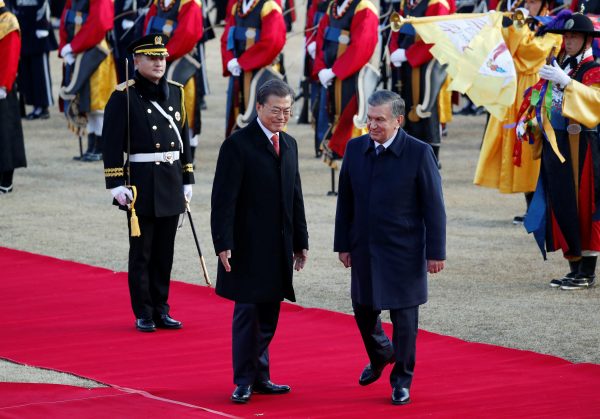The need for South Korea to diversify its export destinations has been underscored amid growing tensions between the United States and China, which together account for almost 40 per cent of South Korea’s exports. To relieve its heavy trade dependency on these countries, Seoul plans to expand its trade network from 58 to 70 countries by the end of 2022.
A South Korea–Uzbekistan FTA was first floated in April 2019 when Moon made a state visit to Tashkent. Feasibility studies began at the end of 2019. By March 2020, the two countries met for a virtual conference to organise a joint study on bilateral free trade.
South Korea and Uzbekistan’s endowments complement each other. While South Korea is technology and capital abundant, Uzbekistan is resource and labour abundant. A synergy effect is expected from mutual economic collaboration.
Uzbekistan is South Korea’s third largest trading partner among the Commonwealth of Independent States (CIS) countries after Russia and Kazakhstan, and South Korea is Uzbekistan’s third major trading partner after China and Russia. Trade turnover between the two countries in 2020 is expected to exceed US$3 billion. South Korea primarilyexports vehicles, machinery, construction material and equipment, while Uzbekistan trades its natural resources and agricultural products.
There is an opportunity for South Korean investment and technology to take advantage of Uzbekistan’s labour abundance, particularly in the development of a budding Uzbek manufacturing industry.
There are already 461 enterprises in Uzbekistan benefitting from South Korean investment — 75 enterprises with 100 per cent South Korean capital and 386 joint ventures. The current total volume of South Korean investment in Uzbekistan exceeds US$7 billion.
A South Korea–Uzbekistan FTA promises significant benefits. Lower tariffs will improve the competitiveness of Uzbek agricultural goods. Uzbek farmers are paying costly tariffs at the South Korean border relative to major competitors. Uzbek exporters of pomegranates or melons, for instance, are whacked with the most-favoured-nation tariff rate of 45 per cent. US farmers face just a 4.5 per cent tariff rate in contrast, due to the longstanding US–Korea FTA. The need for a deal is becoming increasingly urgent as Uzbek farmers find themselves progressively shut out of Russian markets.
But the FTA needs to go beyond trade in goods and services, taking a holistic approach that includes chapters on investment, government procurement, property rights, the environment and labour. While Uzbekistan is looking for new low-tariff markets for its farmers as well as facilitated labour agreements, it is the investment aspect that will be key for South Korea.
Seoul has already emphasised the importance it places on opening up new investment opportunities. South Korean Finance Minister Hong Nam-ki has asked that Tashkent help South Korean companies participate in infrastructure projects across Uzbekistan. A closed state until recently, these joint projects will be crucial for Uzbekistan’s development. South Korea’s rich experience and technological capacity will be vital in Uzbekistan’s revitalised nation-building effort.
Feasibility studies have not been publicly released but, looking ahead, potential challenges and stumbling blocks are already clear. Uzbekistan has been engaging in an honest effort to liberalise its economy since 2016. This is a gradual process and officials still hesitate on reform, especially when state-owned or elite interests are involved.
The local automobile and home appliances industries are considered infant industries. The former is state-owned, having been heavily subsidised and protected with high tariffs since its establishment in 1993. The latter is de facto owned by the Mayor of Tashkent Jahongir Ortiqkhojaev. South Korea’s major exports to Uzbekistan are in these industries, so vested interests could hold back negotiations.
The expected date of FTA completion is yet to be disclosed. In July 2020, Uzbek Deputy Prime Minister Sardor Umurzakov visited Seoul and agreed to speed up preparations for the FTA. In November 2020, it was revealed that the FTA feasibility studies had concluded and an agreement was announced to launch trade talks.
Moon recently urged an all-out effort to achieve tangible wins for the NNP and mentioned expediting the FTA with Uzbekistan in his 2021 new year speech. This may mean that Moon intends to sign the South Korea–Uzbekistan FTA before the end of his presidential term in 2022.
A timely conclusion of an FTA would benefit both sides. South Korean investors will take advantage of their first-mover position in recently opened Uzbek markets. Uzbekistan will have a chance to prove that its new liberal-oriented policies are irreversible and become South Korea’s first free trade partner in the CIS region.
Turakulov Valijon is a recent PhD graduate in International Trade at Inha University.

